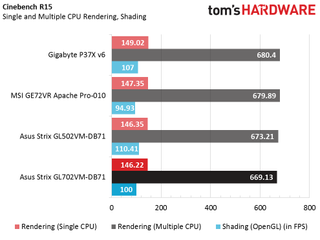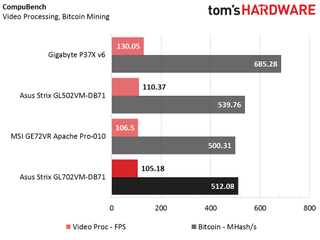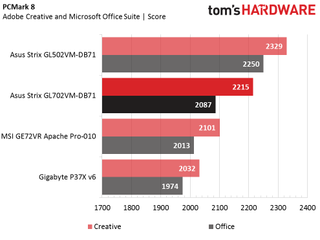Asus Strix GL702VM-DB71 Gaming Laptop Review
Why you can trust Tom's Hardware
Synthetic And Productivity Benchmarks
For our Asus Strix GL702VM-DB71 review, it’s only fitting that we square it off against its 15" counterpart, which we recommended due to its performance and price. The specifications are the same outside of screen size and battery.
The MSI GE72VR Apache Pro-010 will be the Strix 17’s second point of comparison. The Apache Pro is configured with an i7-6700HQ, a 6GB GTX 1060, 12GB of DDR4-2133 memory, a 128GB M.2 SSD, and a 1TB HDD. 16GB of memory seems to be a critical juncture of price and performance, so adding a 12GB DRAM-equipped system will surely illustrate how much of a difference these extra 4GB will make. The Apache Pro will be reviewed shortly, so stay tuned!
Last, to show how much better a GTX 1070 performs, we included the Gigabyte P37X v6 in our comparison set. Besides its GTX 1070, the Gigabyte contains an i7-6700HQ, 16GB of DDR4-2400 memory, a 512GB NVMe SSD, and a well received UHD IPS display.
3DMark
During Fire Strike, Fire Strike Extreme, and Time Spy, the Asus Strix GL702VM-DB71 takes last place across the board, but by a small margin. This margin is so small, in fact, that you shouldn’t experience any perceivable performance difference.



Cinebench R15
Likewise, in Cinebench R15, the GL702VM scores last by a hair’s width. Since all three systems contain an i7-6700HQ, the single and multi-core performance come within single digits of one another. The much more powerful Gigabyte P37X v6 scores a bit better than the Strix 17 in the OpenGL test.

CompuBench
Once again, the Strix 17 takes last place against the other two GTX 1060 laptops, but considering how alike the components are, the difference is negligible. The only clear winner is the Gigabyte laptop, thanks to its GTX 1070.

Storage Benchmark
To test read and write speeds, we run IOmeter from the system's primary drive. The GL702VM’s storage is limited to a 7200RPM 1TB HGST Travelstar 7K1000 HDD. The Gigabyte and MSI laptop's storage results are omitted from the charts because their configurations include SSDs, whose speeds would deflate the results and skew the chart.


This leaves the Strix 15, which almost fittingly also contains a 1TB Travelstar 7K1000. The results are similar.
PCMark 8
The Asus Strix 17’s luck makes a turn for the better in PCMark. The Adobe Creative and Microsoft Office suites are both influenced by a system’s memory, so the GL702VM takes a slight lead over the Apache Pro, which only has 12GB of memory.

Current page: Synthetic And Productivity Benchmarks
Prev Page Introduction And Product Tour Next Page Gaming BenchmarksStay On the Cutting Edge: Get the Tom's Hardware Newsletter
Get Tom's Hardware's best news and in-depth reviews, straight to your inbox.

Microsoft prepares DirectX to support neural rendering for AI-powered graphics — a key feature of the update will be Cooperative Vector support

Intel i9-14900KF overclocker clinches CPU frequency world record at 9.12 GHz — Wytiwx joins Elmor as the only person to push a CPU past 9 GHz

Maker builds a Raspberry Pi 5 powered stereoscopic 3D video camera
-
dingo007 2 memory slots?? on a Skylake based laptop?? #AsusROG gamers build. You have to be joking. A Clevo/Sager has 4 slots for 64Gb capacity.Reply -
Clamyboy74 It makes no sense on how a 17in laptop cant disperse heat more effectively than a 15in. Asus should had added in larger fans/more heatpipes rather than sticking with the same system as their 15in model imo.Reply -
Pompompaihn So...this is a GAMING laptop...and it's been fairly well proven that quad channel effectively does nothing, or in some cases even hinders, performance in gaming where latency is more of a factor than raw speed. For that matter single channel is sometimes even faster than dual channel. So yeah, it makes complete sense for it to be limited to dual channel in a value priced gaming laptop. If you're using this for encoding or editing you'll get decent performance but this isn't your ideal set up, nor is it being marketed as such.Reply
As an owner of this laptop, it's just fine for anything I throw at it. Got it for $1299 and dropped a 500GB 850 EVO m.2 in it that I grabbed for $129. $1430 and it runs like a scalded cat. I'm not sure what more you can ask for at that price point. -
TJ Hooker @PompompaihnReply
# of slots is not the same as number of channels. Typically you have two slots per channel. For most 17" laptops, especially gaming ones, it's pretty standard to have 4 slots. -
William Henrickson Bought the 128GB SSD/1TB version for $1299, removed the HDD for noise reasons and put another 128GB SSD in I had laying around. Will do a 960 EVO next time it goes on sale. Very happy.Reply -
Pompompaihn @TJ HookerReply
Fair enough, but I don't see any advantage at this price point. I can chuck an extra 16GB stick in for 32GB, I don't know what on earth I'd need more than that for in a value gaming laptop. I guess I just don't understand it as a criticism. It's $200 cheaper than comparable 17" 1060 laptops (or, was at time of my purchase...and I did a lot of looking). If you're buying this to run a half dozen VMs, then you purchased the wrong laptop....but as a cheap gaming laptop, this will run -games- as fast as any other similarly equipped gaming laptop regardless of how many more RAM slots it has, and that's the factor in the equation that matters at this price point. -
ledhead11 @POMPOMPAIHNReply
I have to agree with you. I'm running 16GB on my desktop 1080p system and games never really go much more than 2-4 with a few exceptions. I've got 32GB on my other 2 systems and even at 4k I've yet to see it used in games and this is a gaming laptop not a workstation. By the time 32GB is needed for games there's not much about this laptop that wouldn't already be out of date. Vram is another story and at 1080p the 6GB will pretty much cover all games. -
ledhead11 @CLAMYBOY74Reply
I also agree with you. It seems like Asus cut corners to keep the price down by simply making a larger case for the display and probably re-used everything else. A strategy like that would allow most internals to be mass produced for lower costs. Anyone who puts a SSD in one needs to be careful, nand doesn't like high temps. Definite trade off but it could be worse.
I'm happy to see Asus and a few other manufacturers breaking with the idea of $2000-4000 'gaming' laptops. It's really gotten out of control lately. So little but costing so much. Almost every time I see the label 'gaming laptop' slapped on something I feel there's an exec who should be slapped for lying. -
Pompompaihn @LEDHEAD11Reply
Yeah, this bugger does get HOT, but haven't noticed any throttle issues with the CPU/GPU. The 850 EVO is probably going to have a shortened lifespan from heat, but it's a trade off. Nice thing is with the 1TB spinner drive in there I just back up the EVO to it so worst case I'm just back to slow and spinny. -
huyenthoi As an owner of this laptop, it's just fine for anything I throw at it. Got it for $1299 and dropped a 500GB 850 EVO m.2 in it that I grabbed for $129. $1430 and it runs like a scalded cat. I'm not sure what more you can ask for at that price point.Reply
<a href="http://happywheelsaz.com?rel=ugc" >happy wheels</a> |